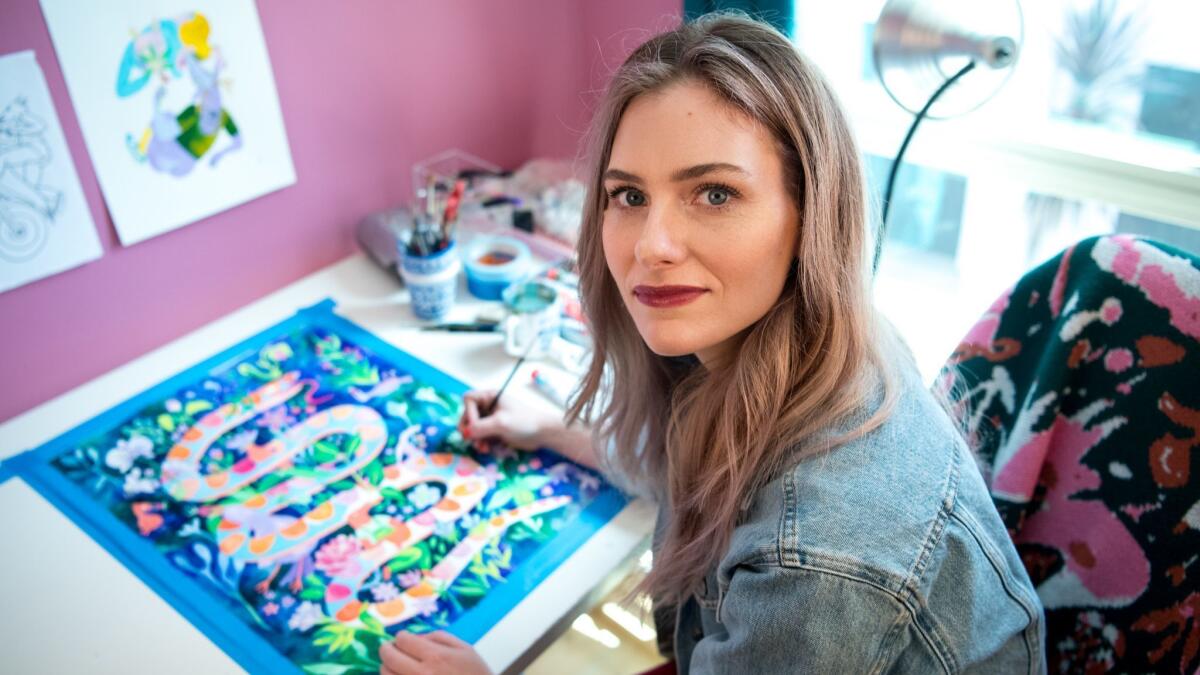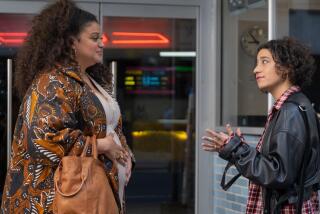The fertile mind of ‘BoJack Horseman’s’ Lisa Hanawalt hatches the surreal ‘Tuca & Bertie’

- Share via
A few episodes into Lisa Hanawalt’s new, terrifically funny animated series “Tuca & Bertie,” there’s a moment when a puffin in a pink suit calls a crowded auditorium to attention. In the process, she tidily summarizes the show’s twisted and (yet undeniably human) perspective.
“Ladies and gentle-birds,” the emcee begins, “and plants, humans and sometimes inanimate objects that talk — what a weird world!”
Even for Netflix viewers who may be coming to “Tuca & Bertie” from Hanawalt’s other television job — character designer and producer of the biting yet melancholy Hollywood satire “BoJack Horseman,” created by her longtime friend Raphael Bob-Waksberg, who also executive produces the new show — the statement can’t be denied.
Featuring stand-up stars Ali Wong and Tiffany Haddish as a pair of bird best friends at the cusp of their 30s, their home of Birdtown is a freewheeling dreamscape where the subway is a snake and freeways loop like roller coasters around cat-infested yarn hillsides and lakes of grape jelly. A few scenes incorporate snippets of live action and claymation and, at one point, Bertie drives her car off the road and her profanity, spilling from the window in puffy balloons of text, builds a bridge to safety.
At times capturing a hallucinogenic meeting between “Broad City” and Tex Avery, “Tuca & Bertie” stands in a strange territory all its own.
“Having worked on ‘BoJack’ for — now I’m working on the sixth season — it felt fun to me to have an opportunity to break the rules a bit and create a different universe where things are a little more loosey-goosey and surreal,” says the 35-year-old Hanawalt on a recent phone call. “And closer to my personal work, where plants can walk around and wear clothing, and there are boobs on buildings. That really is more like my comics and my own little world.”
But for all the visual goofiness, playful puns and anything-goes sense of comic adventure, “Tuca & Bertie” remains grounded in very human realities. Though rendered in candy-colored hues and framed by a sunny, dance-funk soundtrack, the series fearlessly but beautifully makes room for issues around childhood trauma, social anxiety and sexual harassment in a way not dissimilar from “BoJack’s” candid depictions of depression.
“I want to get into that dark stuff because that’s part of growing up as well, and that’s what I like about working with Raphael,” says Hanawalt. “We’re both really drawn to things that are both extremely funny, silly and surreal, and then extremely dark and relatable.”
That said, while “BoJack” and “Tuca & Bertie” from a visual standpoint were born of the same imagination, they exist a great distance from one another.
“I have zero interest in creating ‘BoJack 2’,” Hanawalt says. “I like things a little a grosser, more surreal, more bodily humor, and I’m interested in different story lines. ‘BoJack’ is not the show I would have created or written, and ‘Tuca & Bertie’ is not the show that Raphael would write.”
While TV has grown more adept with nuanced story lines that years ago would have struggled for airtime or even an appropriate level of honesty if forced to run between detergent ads, there’s something about Hanawalt’s line-drawn, anthropomorphized aesthetic that creates a powerful Trojan horse for much heavier material.
Whether it’s Tuca reflecting on the loss of her mother or Bertie describing a nightmarish incident from her childhood, the mix of image and storytelling makes an emotional impact that live action struggles to approach.
“Something about making them cute little birds kind of makes it more universal,” Hanawalt says. “If you’re seeing a human on-screen you have a very specific association with whatever human you’re seeing; they remind you of someone. But if it’s a cartoon animal, then it’s not as specific, it’s more universal, so maybe it’s easier to project yourself onto that.
“We love looking at animals and thinking about their interior lives, and that’s a big part of it too. Because I just really like drawing them,” she adds. “Maybe it makes it even more shocking at times.”

Before Hanawalt’s drawings helped illustrate a struggle with depression in “BoJack Horseman,” she was an indie cartoonist and illustrator who produced three books. Born in Palo Alto and a graduate from UCLA in 2006, the independent-minded Hanawalt needed some persuading before agreeing to work on “BoJack,” which she feared would dominate too much of her time. The series debuted in 2014, and that same year she won a James Beard Award for humor with a comic about chef Wylie Dufresne that ran in the late, lamented food magazine Lucky Peach. Still, making her own series wasn’t always the goal.
“I don’t like to make a lot of plans because I’m just worried I’ll be disappointed,” she says. “It was a surprise to me when ‘BoJack’ actually got picked up by Netflix; it was a surprise to me when it actually aired and when it got picked up for another season. It was a surprise to me that ‘Tuca & Bertie’ actually came to fruition.
“Every time I get the opportunity to do something, I’m like, ‘Yeah, sure, why not? I’ll give it a chance.’ But I never actually expect it to go anywhere,” she adds with a laugh.
In her 2016 book, “Hot Dog Taste Test,” you can find early cameos from what would grow into “Tuca & Bertie” with stories of an outgoing toucan attempting to buy a swimsuit and a sweater-wearing songbird struggling with intimacy as she moves in with her boyfriend. When Bob-Waksberg first began talking with her a few years ago about creating her own show outside of “BoJack,” Hanawalt considered an anthology-style series, but those characters began to stand out.
“[Tuca] was inspired by my id, the most selfish parts of myself. She’s just a character who likes herself; I just know what she’ll do in every situation,” Hanawalt says. “Bertie felt more like what I’m like in real life. I’m actually a little more introverted and anxious. And then when we were talking about show ideas, it just kind of made sense to pair these two characters together and make a show about female friendship.”
Having already gotten to know each other on the stand-up circuit, Haddish and Wong had an immediate chemistry as Tuca and Bertie. As Bertie’s live-in boyfriend Speckle, Steven Yeun (of “Walking Dead” and the indie hit “Burning”) displays a deft comic touch, and the series also features a number of big-name cameos courtesy of Hanawalt’s connections to “BoJack” as well as the stand-up scene (along with hosting a podcast with comic Emily Heller, Hanawalt’s romantic partner is Adam Conover of TruTV’s “Adam Ruins Everything”).
But in another instance of grounding a decidedly unreal show in reality, Hanawalt also wanted to depict how young women — or bird-women — at the cusp of growing up sound and behave. Citing “Broad City” and Hulu’s “Pen15” as inspirations, Hanawalt says, “I just love shows that show how funny and gross women actually are, because that’s how I am with my friends, and I don’t see that represented as often as men being men.
“A lot of adult animation gets pretty raunchy, but it’s all from a male perspective,” she says. “I definitely wanted [‘Tuca & Bertie’] to be an adult show with adult themes.”
While this includes more nudity and frank discussion about sex and sexuality than perhaps expected (“Perverts will love it,” Hanawalt says dryly), there’s also the welcome inclusion of a slapstick standby in at least one perfectly timed, perfectly placed flatulence joke. Upon being reminded of the scene, Hanawalt expresses pride in her work.
“I really carefully chose that fart noise,” she explains. “I mean, never thought that I would have such strong opinions in a sound mix. I’ve never done this before, whatever, but I was like, ‘Uh, can we get a smaller fart?’
“You’d be surprised,” she adds with a laugh, “how much funnier it made it.”

Follow me over here @chrisbarton.
More to Read
The complete guide to home viewing
Get Screen Gab for everything about the TV shows and streaming movies everyone’s talking about.
You may occasionally receive promotional content from the Los Angeles Times.







